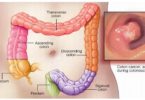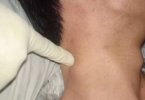What's in this article?
What are cancers of the head and neck?
Cancers that are known collectively as head and neck cancers usually begin in the squamous cells that line the moist, mucosal surfaces inside the head and neck (for example, inside the mouth, the nose, and the throat). These squamous cell cancers are often referred to as squamous cell carcinomas of the head and neck. Head and neck cancers can also begin in the salivary glands, but salivary gland cancers are relatively uncommon. Salivary glands contain many different types of cells that can become cancerous, so there are many different types of salivary gland cancer.
Cancers of the head and neck are further categorized by the area of the head or neck in which they begin. These areas are described below and labeled in the image of head and neck cancer regions.
Oral cavity: Includes the lips, the front two-thirds of the tongue, the gums, the lining inside the cheeks and lips, the floor (bottom) of the mouth under the tongue, the hard palate (bony top of the mouth), and the small area of the gum behind the wisdom teeth.
Pharynx: The pharynx (throat) is a hollow tube about 5 inches long that starts behind the nose and leads to the esophagus. It has three parts: the nasopharynx (the upper part of the pharynx, behind the nose); theoropharynx (the middle part of the pharynx, including the soft palate [the back of the mouth], the base of the tongue, and the tonsils); the hypopharynx (the lower part of the pharynx).
Larynx: The larynx, also called the voicebox, is a short passageway formed by cartilage just below the pharynx in the neck. The larynx contains the vocal cords. It also has a small piece of tissue, called the epiglottis, which moves to cover the larynx to prevent food from entering the air passages.
Paranasal sinuses and nasal cavity: The paranasal sinuses are small hollow spaces in the bones of the head surrounding the nose. The nasal cavity is the hollow space inside the nose.
Salivary glands: The major salivary glands are in the floor of the mouth and near the jawbone. The salivary glands produce saliva.
Head and Neck Cancer Symptoms
People with head and neck cancer often experience the following symptoms or signs. Sometimes, people with head and neck cancer do not show any of these symptoms. Or, these symptoms may be caused by a medical condition that is not cancer.
- Swelling or sore that does not heal; this is the most common symptom
- Red or white patch in the mouth
- Lump, bump, or mass in the head or neck area, with or without pain
- Persistent sore throat
- Foul mouth odor not explained by hygiene
- Hoarseness or change in voice
- Nasal obstruction or persistent nasal congestion
- Frequent nose bleeds and/or unusual nasal discharge
- Difficulty breathing
- Double vision
- Numbness or weakness of a body part in the head and neck region
- Pain or difficulty chewing, swallowing, or moving the jaw or tongue
- Ear and/or jaw pain
- Blood in the saliva or phlegm, which is mucus discharged in mouth from respiratory passages
- Loosening of teeth
- Dentures that no longer fit
- Unexplained weight loss
- Fatigue
If you are concerned about one or more of the symptoms or signs on this list, please talk with your doctor.
What causes head and neck cancers?
Tobacco (including smokeless tobacco, sometimes called “chewing tobacco” or “snuff”) and alcohol use are the most important risk factors for head and neck cancers, particularly those of the oral cavity, oropharynx, hypopharynx, and larynx. Eighty-five percent of head and neck cancers are linked to tobacco use. People who use both tobacco and alcohol are at greater risk for developing these cancers than people who use either tobacco or alcohol alone.
Other risk factors for cancers of the head and neck include the following:
- Oral cavity. Sun exposure (lip); human papillomavirus (HPV) infection is an increasingly frequent cause of oral cavity and oropharyngeal cancers.
- Salivary glands. Radiation to the head and neck. This exposure can come from diagnostic X-rays or from radiation therapy for noncancerous conditions or cancer.
- Paranasal sinuses and nasal cavity. Certain industrial exposures, such as wood or nickel dust inhalation. Tobacco and alcohol use may play less of a role in this type of cancer.
- Nasopharynx. Asian, particularly Chinese, ancestry; Epstein-Barr virus infection; occupational exposure to wood dust; and consumption of certain preservatives or salted foods.
- Oropharynx. Poor oral hygiene; HPV infection and the use of mouthwash that has a high alcohol content are possible, but not proven, risk factors.
- Hypopharynx. Plummer-Vinson (also called Paterson-Kelly) syndrome, a rare disorder that results from iron and other nutritional deficiencies. This syndrome is characterized by severe anemia and leads to difficulty swallowing due to webs of tissue that grow across the upper part of the esophagus.
- Larynx. Exposure to airborne particles of asbestos, especially in the workplace.
Immigrants from Southeast Asia who use paan (betel quid) in the mouth should be aware that this habit has been strongly associated with an increased risk for oral cancer. Also, consumption of mate, a tea-like beverage habitually consumed by South Americans, has been associated with an increased risk of cancers of the mouth, throat, esophagus, and larynx.
People who are at risk for head and neck cancers should talk with their doctor about ways they can reduce their risk. They should also discuss how often to have checkups.
How is head and neck cancer diagnosed?
Head and neck cancer is often difficult to diagnose early because many people only experience mild symptoms. That is why it is so important to see your physician and dentist regularly, especially if you are a smoker or drinker. Three-quarters of all oral cancers can be seen or felt in a physical examination by your physician and many cancerous lesions are detected by dentists. Cancer of the nasal passageways or middle ear may be more difficult to detect.
In addition to a thorough physical examination, your physician also uses blood tests, imaging techniques such as x-rays and magnetic resonance (MRI), tomograms, arteriograms, endoscopy and biopsy to make an accurate diagnosis and develop the most appropriate treatment plan.
How are head and neck cancers treated?
The treatment plan for an individual patient depends on a number of factors, including the exact location of the tumor, the stage of the cancer, and the person’s age and general health. Treatment for head and neck cancer can include surgery, radiation therapy, chemotherapy, targeted therapy, or a combination of treatments.
People who are diagnosed with HPV-positive oropharyngeal cancer may be treated differently than people with oropharyngeal cancers that are HPV-negative. Recent research has shown that patients with HPV-positive oropharyngeal tumors have a better prognosis and may do just as well on less intense treatment. An ongoing clinical trial is investigating this question.
More information about treatment for specific types of head and neck cancers is in the following PDQ® cancer treatment summaries, which are available in patient and health professional versions, as well as in Spanish (the links below go to the patient versions in English):
- Hypopharyngeal Cancer
- Laryngeal Cancer
- Lip and Oral Cavity Cancer
- Metastatic Squamous Neck Cancer with Occult Primary
- Nasopharyngeal Cancer
- Oropharyngeal Cancer
- Paranasal Sinus and Nasal Cavity Cancer
- Salivary Gland Cancer
The patient and the doctor should consider treatment options carefully. They should discuss each type of treatment and how it might change the way the patient looks, talks, eats, or breathes.





